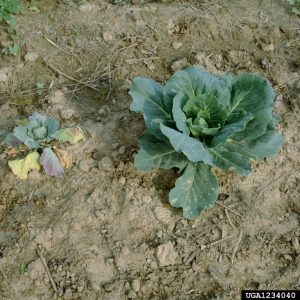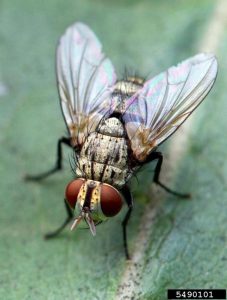Root maggots are one of the most dreaded insect pests in Alaska’s farms and gardens.
They are common pests of most crucifer crops, which include radishes, turnips, cabbage, kale and others. Certain species of root maggot are a problem for onions and other alliums. You may have noticed the maggots tunneling through your turnips when you were slicing veggies for a fresh salad, or maybe you noticed stunted cabbages with yellowing leaves. Or maybe you have been lucky to not have root maggots in your plots– yet!

Cabbage stunted from root maggot damage. Photo by Clemson University, bugwood.org
Whether you have been battling root maggots for years or are new to the fight, there are ways to manage their damage.
To control root maggots, you must first understand their life cycle. It is the larval stage of a small, nondescript fly, about half the size of a housefly. The flies overwinter in the soil as pupae, with adults emerging in the spring as soil temperatures warm over the course of four to eight weeks.

Adult root maggot fly in the family Anthomyiidae. Photo by David Cappaert, bugwood.org
After emerging, the adult flies mate and lay eggs to start the next generation. Eggs are laid at the base of host plants (i.e., your prized cabbage) or in the soil nearby. Once the eggs hatch, the larvae tunnel into the root tissue and feed, causing the damage that you see in your veggies.
There are several options to minimize the damage done, but it is important for home gardeners to know that there are no pesticides approved in Alaska to control root maggots in vegetable gardens. Commercial farms have pesticide options available and should contact their local Extension Agent for advice and recommendations.
Keeping your garden clean is probably the most important thing you can do. This means cleaning up your crucifer crops and not leaving them in your garden beds, especially if they become infested with root maggots this season. As your crucifer crops stop producing, remove the whole plant, including the roots. If you have a hot compost pile include the debris – any larvae that may have been in the roots will not survive the composting process.
Row covers are another option to incorporate into your plan. Floating row covers can be used to blanket new crucifer seedlings and young transplants to prevent adult flies from laying eggs early in the summer. Floating row covers allow some light and water to pass through the fabric and have the added benefit of protecting against frosts.

Floating row cover used to protect from frosts and block root maggot adults from laying eggs on plants. Photo by gardenabby, Flickr.com
Crop rotation should also be used, especially if you are planning to use a row cover. If you use a row cover in an area that had crucifers last year, you run the risk of trapping the emerging adults, where they can happily mate and lay eggs without ever leaving the protection of the cover. Just remember to plant crucifers where you were not growing crucifers last year.
Another idea: plant fast-growing radishes and turnips as an early crop to be harvested before adults lay eggs or as a late crop for a fall harvest.
If you find root maggots to be a substantial problem in your garden year after year, look into using more intensive techniques, such as beneficial nematodes or fall tillage. If you find only a small percentage of plants affected by root maggots, consider yourself lucky and continue to use the practices described above to keep numbers low. And remember, a root maggot can easily be cut out of your radishes or turnips and the veggies will still taste excellent in your salad.
See the Alaska Cooperative Extension Service publication on root maggots for more information: https://www.uaf.edu/wp-content/uploads/sites/637/ces/publications-db/catalog/anr/PMC-00330.pdf
